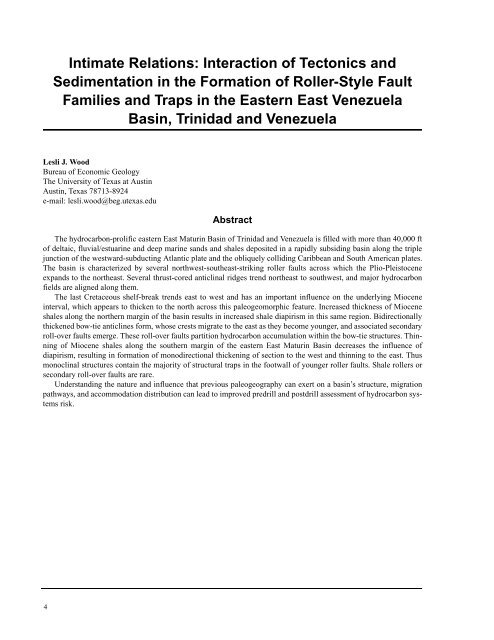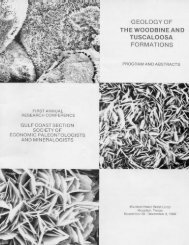Petroleum Systems of Deep-Water Basins - Gulf Coast Section SEPM
Petroleum Systems of Deep-Water Basins - Gulf Coast Section SEPM
Petroleum Systems of Deep-Water Basins - Gulf Coast Section SEPM
You also want an ePaper? Increase the reach of your titles
YUMPU automatically turns print PDFs into web optimized ePapers that Google loves.
Intimate Relations: Interaction <strong>of</strong> Tectonics and<br />
Sedimentation in the Formation <strong>of</strong> Roller-Style Fault<br />
Families and Traps in the Eastern East Venezuela<br />
Basin, Trinidad and Venezuela<br />
Lesli J. Wood<br />
Bureau <strong>of</strong> Economic Geology<br />
The University <strong>of</strong> Texas at Austin<br />
Austin, Texas 78713-8924<br />
e-mail: lesli.wood@beg.utexas.edu<br />
Abstract<br />
The hydrocarbon-prolific eastern East Maturin Basin <strong>of</strong> Trinidad and Venezuela is filled with more than 40,000 ft<br />
<strong>of</strong> deltaic, fluvial/estuarine and deep marine sands and shales deposited in a rapidly subsiding basin along the triple<br />
junction <strong>of</strong> the westward-subducting Atlantic plate and the obliquely colliding Caribbean and South American plates.<br />
The basin is characterized by several northwest-southeast-striking roller faults across which the Plio-Pleistocene<br />
expands to the northeast. Several thrust-cored anticlinal ridges trend northeast to southwest, and major hydrocarbon<br />
fields are aligned along them.<br />
The last Cretaceous shelf-break trends east to west and has an important influence on the underlying Miocene<br />
interval, which appears to thicken to the north across this paleogeomorphic feature. Increased thickness <strong>of</strong> Miocene<br />
shales along the northern margin <strong>of</strong> the basin results in increased shale diapirism in this same region. Bidirectionally<br />
thickened bow-tie anticlines form, whose crests migrate to the east as they become younger, and associated secondary<br />
roll-over faults emerge. These roll-over faults partition hydrocarbon accumulation within the bow-tie structures. Thinning<br />
<strong>of</strong> Miocene shales along the southern margin <strong>of</strong> the eastern East Maturin Basin decreases the influence <strong>of</strong><br />
diapirism, resulting in formation <strong>of</strong> monodirectional thickening <strong>of</strong> section to the west and thinning to the east. Thus<br />
monoclinal structures contain the majority <strong>of</strong> structural traps in the footwall <strong>of</strong> younger roller faults. Shale rollers or<br />
secondary roll-over faults are rare.<br />
Understanding the nature and influence that previous paleogeography can exert on a basin’s structure, migration<br />
pathways, and accommodation distribution can lead to improved predrill and postdrill assessment <strong>of</strong> hydrocarbon systems<br />
risk.<br />
4

















